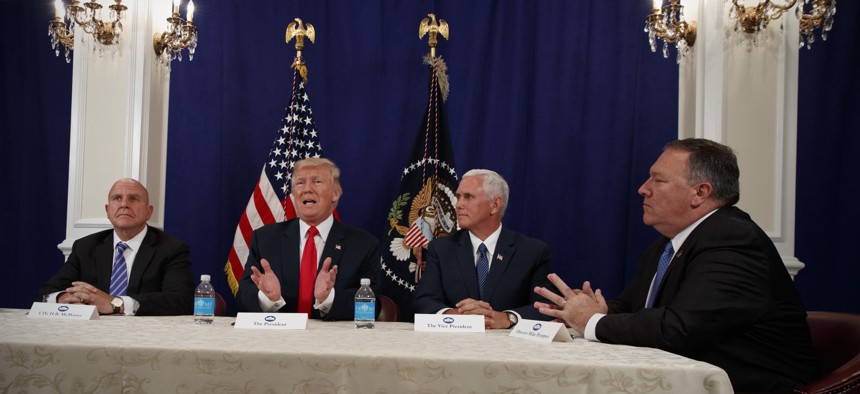
President Donald Trump with, from left, National Security Adviser H.R. McMaster, Vice President Mike Pence, and CIA Director Mike Pompeo, at Trump National Golf Club in Bedminster, N.J., Aug. 10, 2017. Evan Vucci/AP
The Contradiction at the Core of Trump's North Korea Strategy
The president’s national-security advisers say they’re running out of time to do something extremely time-consuming.
In a joint appearance at a security conference on Thursday, CIA Director Mike Pompeo and National-Security Adviser H.R. McMaster exposed a central tension in the Trump administration’s efforts to counter the North Korean nuclear-weapons program. Both officials stressed that North Korea was rapidly approaching a milestone that might prompt the U.S. military to go to war with Kim Jong Un. But they claimed that their current approach consists of peacefully exerting economic and diplomatic pressure on Kim until he agrees to begin dismantling his nuclear arsenal—the kind of campaign that typically takes years to succeed, if it succeeds at all. The timing, in other words, doesn’t add up.
“We’re not out of time, but we are running out of time” to deal with North Korea’s nuclear program, McMaster said at an event organized by the Foundation for Defense of Democracies. Previous administrations had kicked the North Korea can down the road, he argued, and now we’re all out of road.
Pompeo explained why. Kim Jong Un and his scientists are fine-tuning their nuclear-weapons capabilities with each successive missile and nuclear test, he noted, including the capacity to credibly threaten the United States with nuclear weapons by fitting a nuclear warhead on a long-range missile. “They are close enough now in their capabilities that from a U.S. policy perspective, we ought to behave as if we are on the cusp of them achieving that objective,” Pompeo said.
Intelligence estimates can be inexact, he cautioned, but “when you’re talking about months, our capacity to understand that at a detailed level is in some sense irrelevant—whether it happens on Tuesday or a month from Tuesday, we are at a time where the president has concluded that we need a global effort to ensure that Kim Jong Un doesn’t have that capacity.”
“We all want to resolve this without resort to military activity. The president is intent on that as well,” Pompeo said. “And we’re going to pull every arrow in the quiver until such time as we conclude that there’s no alternative. At that point, the president’s made very clear he is prepared to ensure that Kim Jong Un doesn’t have the capacity to hold America at risk [with nuclear weapons], by military force if necessary.”
Yet the “global effort” that Pompeo and McMaster proceeded to describe involves persuading China to crack down on North Korea in ways it has resisted for decades, and compelling North Korea to do something it insists it won’t and that only one other country has done before: give up the nuclear-weapons arsenal that it painstakingly built. It took many years for international economic sanctions and diplomatic isolation to force Iran to agree to restrictions on its nuclear program. And Iran never possessed nuclear weapons or a superpower patron like China.
The time mismatch suggests that one of two things may soon have to give: either the Trump administration’s economic and diplomatic “pressure” campaign against North Korea, or the red line it has drawn on North Korea acquiring the ability to reliably strike the United States with nuclear weapons.
Pompeo hinted that it could be the latter when he offered an expansive definition of what precisely the president’s red line is. When he was asked whether the threat from North Korea would fundamentally change when Kim Jong Un obtained the capability to nuke U.S. cities, the CIA chief admitted that “I’m not sure it changes dramatically, given where we find ourselves today. They are so far along.”
“It’s now a matter of thinking about how do you stop the final step,” he continued. “And then, beyond that, it’s one thing to be able to deliver a single missile along a certain set of trajectories to a certain destination, and another thing to have a country with the capacity to not only process the fissile material at a high volume, but deliver missile systems, technology, guidance systems, all of the pieces to develop a truly robust capability to deliver those types of weapons. So even once you hit the ‘he can do it once’ moment, there’s a great risk that proceeds from the continuation of the development of those programs that far exceeds” the risk of Kim Jong Un being able to fire a single nuclear-tipped missile at the United States.
McMaster, for his part, acknowledged the difficulty of what the administration is trying to pull off. “We are in a race to resolve this short of military action,” he said. “We all know it across the departments and agencies. Our allies and partners know it. China knows it. Russia knows it. So what we need to achieve now is really an unprecedented level of international cooperation.”
“I think the prospects for that are pretty good,” McMaster added, without elaborating on how he could be so optimistic about accomplishing something without precedent in record time.
President Donald Trump, with, from left, Homeland Security adviser Tom Bossert, National Security Adviser H.R. McMaster, Vice President Mike Pence, and CIA Director Mike Pompeo, at Trump National Golf Club in Bedminster, N.J., Aug. 10, 2017.
NEXT STORY: The Bloody End of the Islamic State's Utopian Dream




